When we say the Workhorse W56 is built for real-world performance, we mean it. That’s why we decided to drive it from our manufacturing facility in Union City, Indiana to Orlando, Florida for the FedEx Forward Service Provider Summit, the annual event that brings together FedEx Service Providers from across the United States. Sure, we could have shipped it there by flatbed, but we were excited to use this opportunity as a true demonstration of what our 100% electric step van can handle in real-world conditions.
The journey began at the Workhorse Ranch in Union City, where the W56 was manufactured and has served as a demonstration vehicle. After a 90-mile drive and a brief stop at our headquarters in Cincinnati, Ohio for our teammates to load up, we set off on the 940-mile trek to Orlando.
Skip to our recap video of the 940-mile journey from Cincinnati to Orlando.
Real-World Challenges
On the first segment of the trip, we faced our first challenge: The remnants of Hurricane Helene brought heavy rain and strong winds to Kentucky. Workhorse Customer Success and Training Manager, Steve Conrad, who was behind the wheel, described the experience: “The first part was quite an adventure, driving through the remnants of a hurricane. We had 25-30 mile-per-hour winds and torrential rain. The wind gusts definitely kept things interesting, but the truck remained stable and handled it really well.”
Despite the challenging weather, the W56 stayed on schedule, though it used more energy than expected on this segment due to unusually strong headwinds and running defrost to reduce windshield condensation. “We got through the first part, which at 130 miles was also the longest leg of our trip,” Steve added.
After navigating through the storm, the W56 took on the Appalachian Mountains. Roughly 30 miles north of Knoxville, I-75 begins its longest, steepest climb over the Cumberland Plateau. Uphill climbs are no joke for any commercial truck, but the W56’s electric drivetrain handled the elevation changes effortlessly. Plus, regenerative braking kicked in during downhill descents, boosting efficiency and keeping the battery charged. This feature is crucial for maximizing range and ensuring reliability, especially for operators managing tight delivery schedules.
The next challenge: Atlanta’s notorious traffic, but the W56 was perfectly suited for the stop-and-go conditions, gliding through the congestion while maintaining a smooth, comfortable ride. With each recharge stop, we quickly topped off the battery thanks to the W56’s fast-charging capability, allowing us to keep progressing toward our destination.
The next stretch of our journey brought an unexpected challenge. As we entered South Georgia, we passed through areas without power due to the devastation caused by Hurricane Helene. As of the date of this article, many people across the southeast are still dealing with the restoration and aftermath of the storm, and our hearts go out to them.
With the region’s charging infrastructure impacted, we had to make a quick adjustment. Using apps to locate public fast-charging stations, we rerouted and stopped at the last available “energized” station before traveling through the affected area. That top-off gave us more than enough power to make it through. This moment really highlighted how accessible public charging has become along Interstate 75. Even with the W56’s 150-mile range, we always had reliable charging options nearby, keeping us on track despite the unexpected detour.
The final portion of the trip (through Florida) was less eventful, but it’s where we encountered the hottest temperatures of the journey, in excess of 90°F. The W56 maintained it’s stride with no detectable change in efficiency or performance.
We arrived in Orlando on schedule, just like last-mile delivery requires. Our team felt accomplished and proud to have experienced the W56’s performance firsthand, highlighting its range, durability, and suitability for last-mile delivery. After a little time to rest and recharge (literally) our team, and the W56, were ready for action at the FedEx Forward Provider Summit.
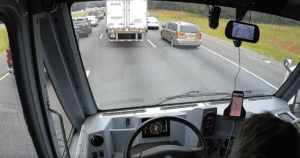
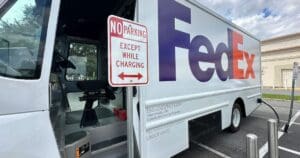
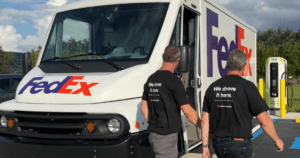
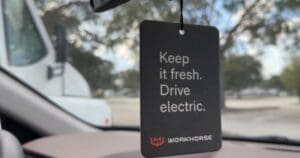
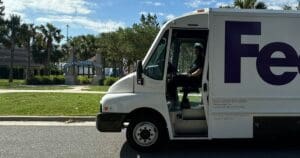
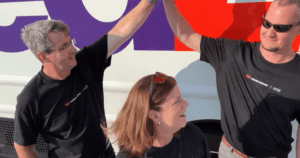
The Results
We covered a distance of 940 miles over 17 hours and 28 minutes of drive time across three days, including 10 charging sessions (the last one topping off to 100% SOC in preparation for the event’s Ride & Drive). We averaged 27 MPGe, which demonstrates the W56’s efficiency, even with all-highway miles and limited opportunity for regen.
After tackling conditions that included 30+ mph winds, heavy rain, potholes, and temps over 90°F, the W56 rolled into Orlando—no flatbed required. This journey wasn’t just a test run; it was proof of real-world performance. We drove it here, and the W56 delivered every mile of the way, showcasing the reliability and durability that make it a gamechanger for last-mile delivery.
Watch highlights from the journey in our recap video:
The dependable W56 step van proves that you can be fully sustainable without sacrificing power. Built on a sturdy, lightweight frame and featuring class-leading cargo capabilities, the W56 is the perfect last-mile option for economical and eco-conscious fleets. The best part? It’s available right now.